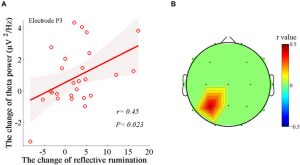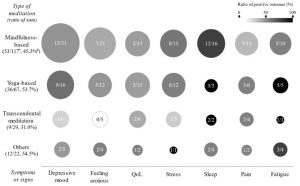Mindfulness Improves Obsessive Compulsive Disorder as well as Drug Treatment
By John M. de Castro, Ph.D.
“most OCD sufferers I know who practice mindfulness find it very helpful in fighting their disorder. To be able to focus on what is really happening in any given moment, as opposed to dwelling on the past or anticipating the future, takes away the power of OCD.” – Janet Singer
Obsessive-Compulsive Disorder (OCD) sufferers have repetitive anxiety producing intrusive thoughts (obsessions) that result in repetitive behaviors to reduce the anxiety (compulsions). In a typical example of OCD, the individual is concerned about germs and is unable to control the anxiety that these thoughts produce. Their solution is to engage in ritualized behaviors, such as repetitive cleaning or hand washing that for a short time relieves the anxiety. The obsessions and compulsions can become so frequent that they become a dominant theme in their lives. Hence OCD drastically reduces the quality of life and happiness of the sufferer and those around them. About 2% of the population, 3.3 million people in the U.S., are affected at some time in their life.
Fortunately, Obsessive-Compulsive Disorder (OCD) can be treated. Mindfulness training including Mindfulness-Based Cognitive Therapy (MBCT) has been shown to be effective in treating OCD. A therapeutic technique that contains mindfulness training and Cognitive Behavioral Therapy (CBT) is Acceptance and Commitment Therapy (ACT). It focuses on the individual’s thoughts, feelings, and behavior and how they interact to impact their psychological and physical well-being. It then works to change thinking to alter the interaction and produce greater life satisfaction. ACT employs mindfulness practices to increase awareness and develop an attitude of acceptance and compassion in the presence of painful thoughts and feelings. ACT teaches individuals to “just notice”, accept and embrace private experiences and focus on behavioral responses that produce more desirable outcomes. This suggests that ACT may be an effective treatment for obsessive-compulsive disorder (OCD),
In today’s Research News article “A randomized clinical trial: Comparison of group acceptance and commitment therapy with drug on quality of life and depression in patients with obsessive-compulsive disorder.” (See summary below or view the full text of the study at: https://www.ncbi.nlm.nih.gov/pmc/articles/PMC8943588/ ) and colleagues recruited patients with Obsessive-Compulsive Disorder (OCD) and either treated them with drugs (SSRIs) or with Acceptance and Commitment Therapy (ACT) twice weekly for 1 hour for 4 weeks. They were measured before and after treatment and 3 months later for depression, anxiety, perceived stress, and quality of life.
They found that in comparison to baseline both groups had significant decreases in depression and significant increases in quality of life and these improvements were maintained the 3-month follow-up. Hence, Mindfulness training is as effective as drugs in treating Obsessive-Compulsive Disorder (OCD).
Since mindfulness training, unlike drugs, doesn’t have significant side effects, it would appear to be the preferred treatment for Obsessive-Compulsive Disorder (OCD),
“The struggle of the OCD sufferer is one in which certain internal experiences (thoughts, etc.) are viewed as unacceptable, whereas others are allowed to pass by without critique. Mindfulness suggests a different perspective on the presence of these internal experiences, that they be simply noticed, not judged or pushed away.” – Sheppard Pratt
CMCS – Center for Mindfulness and Contemplative Studies
This and other Contemplative Studies posts are also available on Twitter @MindfulResearch
Study Summary
Ebrahimi, A., Nasre Esfahan, E., Akuchekian, S., Izadi, R., Shaneh, E., & Mahaki, B. (2022). A randomized clinical trial: Comparison of group acceptance and commitment therapy with drug on quality of life and depression in patients with obsessive-compulsive disorder. Journal of research in medical sciences : the official journal of Isfahan University of Medical Sciences, 27, 9. https://doi.org/10.4103/jrms.jrms_449_21
Abstract
Background:
Acceptance and commitment therapy (ACT) is one of the newest treatment strategies that has been developed rapidly to improve the treatment of patients with obsessive–compulsive disorder (OCD). The aim of this study was to evaluate and compare the effect of ACT and selective serotonin reuptake inhibitors (SSRIs) drugs on the severity of depression symptoms and quality of life (QOL) in obsessive–compulsive patients.
Materials and Methods:
A randomized clinical trial with a control group was conducted including 27 patients with OCD. Based on the Diagnostic and Statistical Manual of Mental Disorders-5 criteria for OCD diagnosis, participants were recruited from Tamasha Counseling Center and obsessive–compulsive clinic in the Psychosomatic Research Center in Isfahan, Iran. Selected patients were allocated to two groups (14 in ACT the group and 13 in the drug group with SSRI with a simple random sampling method. ACT group was treated by an ACT therapist in eight 1-h sessions. Data were collected by the World Health Organization QOL Questionnaire (WHOQOL-BREF) and Depression subscale of DASS-42 at admission, after the intervention, and 3 months thereafter. Therapists and evaluators were blind to each other’s work. Data were analyzed using analysis of variance with repeated measures method using IBM SPSS Statistics software (V 23, IBM Corporation, Armonk, NY, USA).
Results:
Results revealed that both treatments (ACT and SSRIs drug therapy) had significant impacts on reducing depression subscales scores and increasing WHOQOL-BREF scores at posttreatment (P < 0.05). There were no significant differences in QOL scores between the two groups after the intervention and follow-up (P > 0.05). Nevertheless, drug therapy presented a significantly greater improvement in depression scores of patients than those resulting from ACT (P = 0.005). The persistence of treatment effects continued after 3 months (follow-up) in both groups.
Conclusion:
ACT is equal to SSRIs drug therapy in terms of improving QOL in patients with OCD. However, SSRIs are more effective in treating depression in obsessive–compulsive patients. It may be presumed that ACT without any chemical side effect is equal to drug and is preferred for patients who either cannot use drugs or prefer not to have a drug treatment.
https://www.ncbi.nlm.nih.gov/pmc/articles/PMC8943588/









